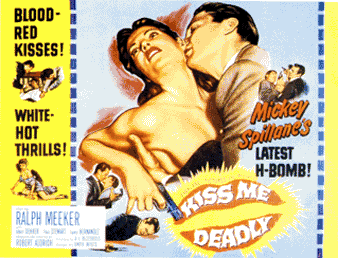 Study
Questions: Week Four
Study
Questions: Week Four  Study
Questions: Week Four
Study
Questions: Week Four
Genre Patriotism: Communists, Criminals, and the Enemy Within
Pickup on South Street (1953)
Kiss Me Deadly (1955)
This week's films share both a common subject, Cold War espionage, a common cinematic style, the film noir. Noir films, which flourished from the mid-1940s to the mid-1950s, were as much a film style as a film genre. They favored dark urban streets, disorienting camera angles, and maze-like settings. This style complemented narratives which featured characters who find themselves entrapped in circumstances they can neither fully understand or control. Although detective thrillers and gangster films were the genres best suited to the noir style, it can be found in many other genres as well. We have already seen its influence in The Fountainhead, High Noon and On the Waterfront. Stories of communist subversion were tailor-made for the paranoid noir style as Sam Fuller's Pickup on South Street and Robert Aldrich's Kiss Me Deadly make evident.
Despite their similarities, however, these films treat the subject of communist agents in search of American military secrets in very different ways, and it is the contrast between these classic examples of the film noir that we want to examine. While Pickup on South Street treats the struggle between loyal Americans and unscrupulous communist agents as a struggle between good and evil, between patriotic Americans (which even includes petty criminals) and a dangerous enemy, Kiss Me Deadly presents a much darker vision. The tactics of the communists and the American security forces are often similar, and the hero finds himself a victim of circumstances which may doom him.
1. How does the opening sequence of Pickup on South Street suggest that anyone might be caught up in the machinations of communist agents?
2. What is your first reaction to the federal agents watching Candy? Why do they seem so threatening?
3. What ties Candy to Joey? What does the film imply about her past?
4. In what ways does Moe, despite her profession as an informer, represent the moral center of the film?
5. How do the sequences showing Skip McCoy hiding under his floating shack and Joey fleeing the police in the dumb waiter illustrate a variety of film noir techniques?
6. What is the significance of the lies which all the character seem to tell (not any specific lie but the common practice of lying, for good or bad -- and not getting caught)? Think, for instance of Candy telling the police that Skip asked her to return the microfilm.
7. Fuller's films are full of details which, though not advancing the action, are striking and offbeat. What, if any, is their thematic significance? Consider the way Skip reads the microfilm in the New York Public Library, Lightnin' Louie eating as he talks to Moe, the funeral barge sequence, or the cat in the alley where Joey is trapped by the police,
8. Why does Moe mistake the FBI agent for a "second-story man" and later in the film the police are compared to criminals? What is implied in the equation of the police with the criminals they pursue?
9. How does Pickup on South Street echo the portrait in Big Jim McLain of communists as members of the upper levels of society? What scene emphasizes class distinctions between Candy and her superiors?
10. What makes Skip change his mind about "doing business" with communists? How does this change justify Moe's faith in him? Why does Fuller place such emphasis on what the FBI agent calls the "difference between a traitor and a pickpocket"? What does the behavior of Skip, Candy, and Moe suggest about the basic ideals uniting all Americans?
11. The conclusion implies that Skip, under the influence of Candy, will life a reformed life. How convincing is this ending? In what ways does it support the idea that resisting communism can be a form of spiritual redemption?
12. Moving on to Kiss Me Deadly, how are the film noir techniques used in the opening sequence which precedes the credits? Most films use such sequences to establish the setting of the events about to unfold and/or to identify the central characters, that is to make the narrative events more clearly understandable. How does Aldrich's opening reverse this practice? What, in your opinion, is the thematic reason for doing so?
13. Why does the victimized Christina so closely resemble her roommate, the treacherous impostor Lily Carter? For that matter, why are the acts of the federal agents led by Pat Chambers and those of the communists so difficult to tell apart? Consider the issue of who imprisoned Christina in a mental institution.
14. Explain the significance of Mike Hammer's ambivalent attitude toward women, which is emphasized throughout the film. What does his behavior say about relations between men and women?
15. Kiss Me Deadly has long been regarded as an exceptionally hard-boiled, violent film. How would you compare the violence in Aldrich's film to that commonly seen on the screen today? Could you say that Aldrich's portrayal of violence is less graphic but more frightening? Why? Why not?
16. Is the subject of nuclear espionage the real concern of the film, or is it only an occasion to explore an underworld of violence, betrayal, and entrapment -- the familiar themes of noir films? Explain why you made your choice.
17. What is the significance of Velda's relationship with "Mr. Friendly"? What does it reveal about her, her job with Mike Hammer, and the moral climate of the world in which they exist?
18. What is the significance of the literary allusions which appear throughout the film -- i.e. Christina Rossetti, classical mythology, etc.
19. After seeing the film's final shot, what, in your opinion, is the fate awaiting Mike Hammer and Velda? Do you see a different possible fate in the alternate ending? Why? Why not?